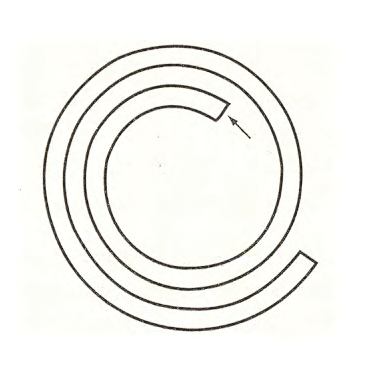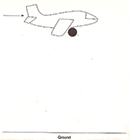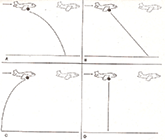Teaching Current Directions
Teaching Current Directions in Psychological Science
C. Nathan DeWall, University of Kentucky, and renowned textbook author and APS Fellow David G. Myers, Hope College, have teamed up to create a series of Observer columns aimed at integrating cutting-edge psychological science into the classroom. Each column will offer advice and how-to guidance about teaching a particular area of research or topic in psychological science that has been the focus of an article in the APS journal Current Directions in Psychological Science. Current Directions is a peer-reviewed bi-monthly journal featuring reviews by leading experts covering all of scientific psychology and its applications, and allowing readers to stay apprised of important developments across subfields beyond their areas of expertise. Its articles are written to be accessible to non-experts, making them ideally suited for use in the classroom.
Fast Thinking Feels Good
Why Smart People Can Make Not-So-Smart Judgments
Fast Thinking Feels Good
By C. Nathan DeWall
You wake up. Your phone blinks. You touch the screen, slide your finger, and chills shiver down your spine. “See me tomorrow,” says the email your boss sent at midnight. Your thoughts accelerate. “What does she want? Why did she write so late? Am I in trouble? The company is in trouble. This down economy! I’m getting fired. Why me? Where will I work? I have skills. There are other companies. I have no skills. Where will I apply? Can we move? What will my parents think? How will the kids react to changing schools? I can do this. We can do this. No matter what.”
We think. It helps us. Errands, plans, and goals require thought. Synapses fire. Action potentials race down axons. Chemicals bathe our brains with neurotransmitters. Thoughts guide action, from ordering a coffee to avoiding predators. What we think matters. But according to Emily Pronin of Princeton University, how fast we think matters, too.
Making people think fast boosts their happiness, energy, riskiness, and self-confidence. In an impressive program of research, Pronin and colleagues have documented these effects using many ways to speed up thinking. In one study, participants read trivia statements at fast or slow speeds (Chandler & Pronin, 2012). Next, they completed a risk-taking task. Participants could earn money — but only if they didn’t take too many risks. Fast-thinking participants took the most risks and earned the least money. On the bright side, having people read at twice their normal reading speed increased their positive emotion (Pronin & Wegner, 2006).
Pronin (2013) argues that fast thinking prepares people to take immediate action. Feeling good nudges that process along, as does increased energy. If you spy a moose while running on a trail, it will behoove you to take swift and confident action even if it involves some risk. You may even experience an “a-ha” moment that provides a creative solution you would not have considered if you were thinking at a normal or slow pace (Yang & Pronin, 2012).
To illustrate the power of fast thinking, instructors may conduct the following activity. Hand out envelopes stuffed with a single sheet of paper. By random assignment, half of the envelopes should have the following instructions, “Read the next 10 statements as fast as you possibly can.” This is the fast thought group. Handing out the other half of the envelopes, ask students to read the same statements at their normal reading speed. This is the normal speed group. Have the students open their envelopes, read their personalized instructions, and then show them these 10 neutral statements on a PowerPoint slide (Velten, 1968):
Read These Statements:
1. Oceans cover 71 percent of the earth’s surface.
2. Alkaline power cells generally work longer than ordinary batteries.
3. Monarch butterflies fly slowly but have been sighted hundreds of miles at sea.
4. The Olympics are held every four years.
5. Half a day’s boat ride away from Athens lies the isle of Mykonos.
6. Sugar cane and sugar beets are grown in 112 countries.
7. Many of the mountain peaks in the Rockies are more than 14,000 feet high.
8. The Appalachian Highlands are worn-down mountains and plateaus stretching from northern Alabama to the St. Lawrence River in Canada.
9. The greatest distance the earth is from the sun is 94,452,000 miles.
10. The Nile River is the world’s longest river.
Next, have students report their current level of happiness (“At the current moment, how happy are you?”), energy (“At the current moment, how energetic do you feel?”), and self-confidence (“How much confidence do you have in yourself right now?”). In the final task, students will complete the Asian Disease Problem, which APS William James Fellows Amos Tversky and Daniel Kahneman (1981) designed to measure risk preferences. Ask them to consider the following:
Imagine that the United States is preparing for the outbreak of an unusual Asian Disease, which is expected to kill 600 people. Two alternative programs to combat the problem have been proposed:
- Program A: If Program A is adopted, 200 people will be saved.
- Program B: If Program B is adopted, there is a 1/3 probability that all 600 people will be saved, and 2/3 probability that no people will be saved.
Which program would you favor?
Both programs have an equal expected value, but Program B is riskier than Program A. Tally students’ responses. Determine whether the fast thinking group reported higher levels of happiness, energy, self-confidence, and preferred the riskier option. The class can discuss when taking risks can prove beneficial or costly. Discussion can also center on practical uses for fast thinking — and when it is and is not appropriate to speed up another person’s thoughts. Are there downsides to making someone feel happy, energetic, and self-confident?
A racing mind is often an unquiet, manic mind (Jamison, 1997). But thinking fast can bring tremendous benefits. It prompts people to pounce rather than ponder, to act rather than react, and to brim with confidence rather than with reticence. By thinking fast, we have the confidence to bob our heads in the boss’s door upon entering the office and ask, “You said you wanted to see me?” “Yes, I just learned that we’re promoting you,” she says. “Congratulations!” Fast thinking can be frightening, but it also feels good.
Why Smart People Can Make Not-So-Smart Judgments
By David G. Myers
“In creating these problems, we didn’t set out to fool people. All our problems fooled us, too.”
-Amos Tversky (1985)
Say this for traditional intelligence tests: They are impressively reliable. And they do a reasonably good job of predicting success in school and in vocations that demand general mental ability (Deary, Whalley, & Starr, 2009; Schmidt & Hunter, 2004).
Yet, as APS Fellow Keith Stanovich of the University of Toronto has dedicated much of his career to documenting: even smart people sometimes display surprisingly bad or biased judgments. Indeed, his astonishing (and astonishingly consistent) finding is that intelligence and rational thinking are often minimally related. High intelligence does not guarantee good real-world decision-making.
Examples of human irrationality, even among bright people, are amply described in Kahneman’s (2011), Thinking, Fast and Slow. They will also be familiar to teachers and students of psychology. Recall:
- The overconfidence phenomenon (the tendency to be more confident than correct).
- The framing effect (the effect of how a question or issue is posed — as when people are more accepting of a surgery with a 95 percent survival than a 5 percent death rate).
- The discounting of base-rate information (and favoring anecdotal information) when making social judgments.
- The availability heuristic (estimating the likelihood of events based on how readily examples, such as of plane crashes, come to mind).
- Illusory correlations (perceiving associations where none exist).
- Illusions of control (presuming that one’s behavior can control chance events).
- Perceiving order in random sequences (attributing causal explanations to random “hot streaks” in sports and investing).
- Belief perseverance (clinging to an initial belief and the reasons it might be true, even after the discrediting of the original basis for the belief).
- Hindsight bias (overestimating, after an event, one’s ability to have foreseen it).
- Self-serving bias (the tendency to perceive oneself favorably).
- Mood effects on memories and judgments (our moods color how we recall and judge the world).
- Ingroup bias (the tendency to favor and perceive virtue in one’s group).
Moreover, to this incomplete list, Stanovich, and researchers West, and Toplak add another: a pesky myside bias — a type of confirmation bias that leads us to seek and favor perspectives that are sympathetic to our own. Thus, in one of their experiments, American students were much more likely to favor banning an accident-prone German car from American roads than a comparable American car from German roads. We make moral judgments with a myside bias (and, once again, our vulnerability to the bias is unrelated to our verbal ability).
Such “dysrationalia,” says Stanovich (2009), can lead smart people into thinking and doing foolish things — to resist vaccinating their children, to fear flying, to try quack remedies, to make bad investments, to overconfidently launch wars. That’s because virtually all these biases are like perceptual illusions: they are but modestly restrained by general mental ability. Stanovich’s point — that intelligence tests simply don’t assess much of the rationality that facilitates everyday wisdom — is a take-home message worthy of any introductory psychology course.
While Stanovich and his colleagues continue with their efforts to train people to think smarter, and to construct an RQ (rationality quotient) test to complement existing IQ tests, psychology instructors can enable students to use class demonstrations that help students experience and appreciate dysrationalia. In addition to demonstrations of most of these biases (found in instructors’ manuals, and at tinyurl.com/JonMuellerDemos), here are some other simple and fun demonstrations of dysrationalia:
APS Fellow Michael McCloskey’s (1983) studies of “naïve physics” invited smart Johns Hopkins students to answer these two questions (which David Myers adapted in his book Intuition: Its Powers and Perils):
1) The diagram shows a curved tube, lying flat on a table. A BB is shot into the opening and out the other end. With your finger on the page, draw the BB’s path through the tube and after it shoots out the tube.

2) While flying at a constant speed, a plane drops a bowling ball. Draw the path the ball will follow (ignoring wind resistance) and show where the plane will be as the ball hits the ground. If a BB were dropped at the same time as the bowling ball, which would hit the ground first?

3) Or how about some simple arithmetic? Here’s one that, in Dave’s experience, most students miss (but more often get right after animated debate in small groups): A farmer bought a horse for $60 and sold it for $70. Then the farmer bought the horse back for $80 and sold it again, for $90. How much money did the farmer make on this horse trading?
Answers:
1) The BB exits in a straight line. Nearly half of McCloskey’s university students expected the BB would honor the curve. (Imagine watering your garden with a hose whose water honored the hose’s coil!)
2) The ball falls in a forward arc (a, below), as only 40 percent of McCloskey’s students anticipated.

3) Most people say $10 is the answer. However, the farmer actually made $20, as should be evident if people will make a simple table of money spent and received. Or reread the question with this second sentence: “Then the farmer bought some bricks for $80 and sold them for $90.” (Should it matter whether the second deal was bricks or a horse?) If still unconvinced, tell students to get out some Monopoly money, go through the transactions, and see how much they profit.
The bottom line: Thinking about thinking can help us think smarter. And besides, it’s just plain fun.
References
Chandler, J. J., & Pronin, E. (2012). Fast thought speed induces risk taking. Psychological Science, 23, 370–374.
Deary, I. J., Whalley, L. J., & Starr, J. M. (2009). A lifetime of intelligence: Follow-up studies of the Scottish Mental Surveys of 1932 and 1947. Washington, DC: American Psychological Association.
Jamison, K. R. (1997). An unquiet mind: A memoir of moods and madness. New York: Vintage.
Kahneman, D. (2011). Thinking, fast and slow. New York: Farrar, Straus and Giroux.
McCloskey, M. (1983). Naive theories of motion. In D. Gentner and A L. Stevens (Eds.), Mental Model. Hillsdale, NJ: Erlbaum.
Pronin, E., & Wegner, D. M. (2006). Manic thinking: Independent effects of thought speed and thought content on mood. Psychological Science, 17, 807–813.
Schmidt, F. L., & Hunter, J. (2004). General mental ability in the world of work: Occupational attainment and job performance. Journal of Personality and Social Psychology, 86, 162–173.
Stanovich, K. E. (2009, November/December). The thinking that IQ tests miss. Scientific American Mind, pp. 32–37.
Tversky, A., & Kahneman, D. (1981). The framing of decisions and the psychology of choice. Science, 211, 453–458.
Velten, E. C., Jr. (1968). A laboratory task for the induction of mood states. Behavior Research and Therapy, 6, 473–482.
Yang, K., & Pronin, E. (2012). The causal impact of thought speed on subsequent creativity. Manuscript in preparation.





Comments
The ball falling form the airplane would follow none of the paths depicted. Since the question instructed us to ignore wind resistance, the ball will not accelerate (positively or negatively) relative to the location of the plane along the horizontal axis. A curve like A should remain but land closer to where the straight line of B does.
I am a slow reader but I can see who errors are made by reading fast. That makes me feel better now!. However, it I did the test of reading fast and noticed a change in my mood and confidence even though I did not understand or remembered the reading material clearly. When I solved problem #3, as I rushed into answering the question, I gave the incorrect number which was ten dollars first but was confident until the happy moment passed and I went over the question again.
APS regularly opens certain online articles for discussion on our website. Effective February 2021, you must be a logged-in APS member to post comments. By posting a comment, you agree to our Community Guidelines and the display of your profile information, including your name and affiliation. Any opinions, findings, conclusions, or recommendations present in article comments are those of the writers and do not necessarily reflect the views of APS or the article’s author. For more information, please see our Community Guidelines.
Please login with your APS account to comment.